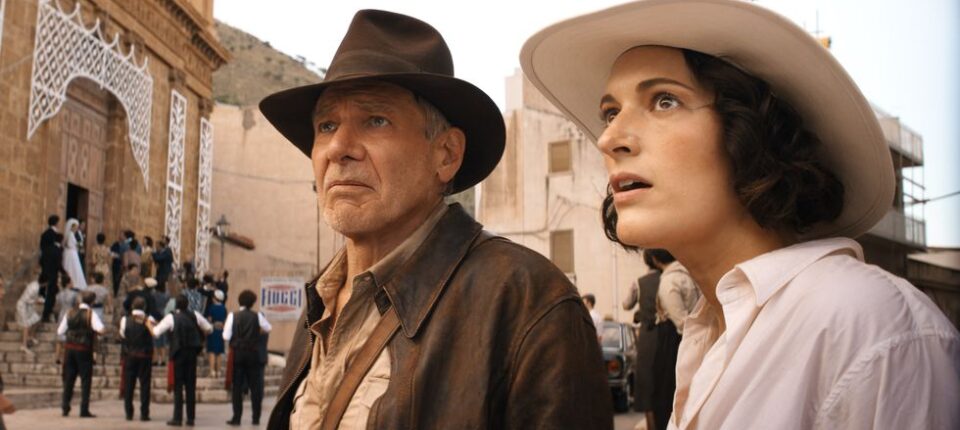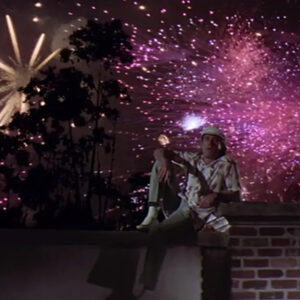There are things you want from an Indiana Jones movie. You want Indy to yell directions at a stunned, fuddy-duddy academic while trying to dodge bullet spray. You want Indy to shove the lid off a big stone tomb, and maybe even yank an antique out from the stiff grip of the skeleton inside that tomb. You want to watch him shimmy through a cavern full of vermin and translate an ancient language very quickly by sight. You want him to growl at Nazis. You want the hat and the whip and the grin and the eye rolls and the French horns.
Indiana Jones and the Dial of Destiny is a good student of the canon that came before it. It is the fifth in a series which was originally intended to have five installments but for a very long time (the nearly two decades since the release of Last Crusade in 1989) only had three. Indiana Jones and the Dial of Destiny faces many of the same challenges that Indiana Jones and the Kingdom of the Crystal Skull, the long-awaited fourth volume, did—namely, how to capture the pleasures of the original franchise while delivering a new, compelling story.
And, of course, how to rely on Indy as an action hero now that he’s considerably older; his character is 58 in the fourth film, and 70 in the new one. (In each film, Harrison Ford, the series’ star, is 65, and 80, respectively.) Indiana Jones and the Dial of Destiny works very hard to do right by the series, while also remaining realistic given newer constraints, and for the most part, it pulls it off. It is a rousing, genuinely entertaining return to adventure with cinema’s greatest action hero. I’d probably rank it higher than #4.
The movie begins with a flashback to 1944, when a 45-year-old Indy is, once again, embroiled in yet another attempt to rescue a priceless historical artifact from the Nazis, aided by a bumbling British scholar named Basil Shaw (Toby Jones). But he winds up picking up another relic, the Antikythera—part of a dial designed by the Greek mathematician Archimedes that is believed, by some, to have the ability to plot cracks in the fabric of time that can allow for travel through it. The Antikythera is the hobbyhorse of Nazi physicist Dr. Voller (Mads Mikkelsen), who believes that, instead of Biblical artifacts, it is the instrument the Nazis should use to win the war.
The opening sequence—in which Indy and “Baz,” as Indy calls him, attempt to flee the Germans and bring along the Antikythera—is a nailbiting romp made possible through de-aging CGI that transforms present-day Harrison Ford into his 45-year-old self. Mostly, it’s an extremely impressive computerized reconstruction, although it’s not the only CGI thing going on; there are a few nighttime scenes on an over-stylized careening train that made me feel like I was watching a much darker sequel to The Polar Express.
It’s worth reiterating that, taking in this opening sequence, which is 25 minutes long, I was genuinely unbothered by Indy’s younger-looking, ever-so-slightly rubbery visage, but I did worry that this portended a heavy reliance on CGI, overall, at the expense of practical effects. A lot of the fun of the original Indiana Jones trilogy is the handmade component, that scenes do in fact feel like they take place on soundstages decorated to look like caves via spray-painted foam, and that their incredible action sequences are combinations of editing tricks and impeccable choreography. But the good news is that the rest of the film, which features our regular, naturally-aged Harrison Ford, does indeed return to this more tactile approach to action filmmaking.
This is the first Indiana Jones film not directed by Steven Spielberg, and while you can sense his absence somehow, the efforts from director-surrogate James Mangold are sufficient. It’s a fact that nobody is as creative and thoughtful as Spielberg in terms of shot construction; chances are, an individual still by Spielberg contains more imagination and meaning and character than a whole scene by Mangold. But Mangold is a more than capable technical director, and the film still works. Mostly, I think this is because of the insane magnetism Ford emanates whenever he plays this character; he has been, many times before, the salvation of this franchise, which has been known to occasionally lean into weird narrative experiments and traffic in some casual racism. Ford’s just as great here, mixing his character’s cocky, scrappy, wiseass personality with some of the age-appropriate crankiness that he, as an actor, has made his shtick on talk-shows and in interviews.
Indiana Jones and the Kingdom of the Crystal Skull ends on a happy note, depositing Indy into a satisfying domestic situation. After its opening sequence, Indiana Jones and the Dial of Destiny begins in earnest in 1969 in New York City, at a bit of a low point. Marion (Karen Allen) is divorcing him, and he lives in a messy apartment down the hall from some annoying hippies. For ten years now, he’s taught archaeology at Hunter College, boring the very demographic of undergraduates he once enthralled.
A bright spot in this surprisingly bland grind is a visit from Helena Shaw (Phoebe Waller-Bridge), the now-deceased Baz’s daughter/Indy’s goddaughter. She wants Indy’s help in tracking down the Antikythera, the thing her father was obsessed with until the day he died (man, I love when an Indiana Jones movie features a professor dad with a handwritten notebook full of well-researched details pertaining to one historical object), after his fateful encounter with it while fleeing Nazi territory. But Indy’s not planning on embarking on another breakneck adventure… at least for a whole minute or so, until a group of people start chasing and shooting at them.
The CIA, mostly in the form of a field agent named Mason (Shaunette Renée Wilson), is on Helena’s tail. And so is Dr. Voller, who, in the many years since World War II, has, in Wernher von Braun-fashion, been working for the U.S. Government on their rocket program, and has helped America get to the moon. Voller, now known as Schmidt, has two lackeys, a trigger-happy, Southern-drawling psycho named Klaber (Boyd Holbrook) and a giant named Hauke (Olivier Richters), and let’s just say that they don’t play by the CIA’s more restrained rules. Voller is using his American connections to track down the Antikythera, and will stop at nothing to get it.
So, Indy and Helena wind up on a cross-Mediterranean journey, hunting artifacts, outrunning Nazis, dealing with various personal ambitions and or crises. They are aided by a Short-Round-esque Moroccan pickpocket named Teddy (Ethann Isidore) and a suave Spanish sailor named Renaldo (Antonio Banderas, who does not get enough screen time) and, in a wonderful cameo, Indy’s longtime Egyptian friend Sallah (John Rhys-Davies).
I don’t want to spoil too much about the plot, but I will say that the film has several incredible setpieces, ones that we haven’t seen in Indiana Jones movies before, and therefore feel extremely distinctive. There are also, don’t worry, motorcycle chases and horseback chases and car chases through outdoor markets. There are some incredible whipcracks and punches and kicks. The stuntwork and effects are masterful, a treat even if you somehow don’t care about the rest of it.
I’ll also add that it’s charming how the film’s MacGuffin is a time-traveling device, while it’s also a flashback-laden farewell to a beloved character who rocked cinema for forty-two years. Ticking noises abound, characters are really into their watches, the mise-en-scene is full of clocks. Even though time has marched onward, Indy’s still our guy. He shouts “it belongs in a museum!” while gripping an antique. He still gets dewy-eyed when he comes face-to-face with history.
Whatever else is entertaining about it, Indiana Jones and the Dial of Destiny is a joy for how it takes us down memory lane with this character and his friends, one last time. Let’s do it all again, for old times’ sake.

















